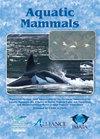Modeling Suitable Habitats of Indo-Pacific Humpback Dolphins (Sousa chinensis) in a Highly Urbanized Bay
IF 0.9
4区 生物学
Q4 MARINE & FRESHWATER BIOLOGY
引用次数: 1
Abstract
Indo-Pacific humpback dolphins (Sousa chinensis) live in coastal waters that have experienced considerable anthropogenic disturbances. Specifically, along the coasts of highly urbanized regions, available habitats have decreased in both space and scale. This study used Maxent software to simulate the distribution of suitable habitats for S. chinensis during the dry and wet seasons in Xiamen Bay. We also aimed to identify key environmental factors influencing habitat distribution, with the goal of using our results to analyze conservation gaps and propose adjustments. We found that during the dry season, S. chinensis were mainly distributed in the Western Harbor, Jiulong River Estuary, and the mouth of Tongan Bay. During the wet season, they were distributed in the south of Western Harbor, Jiulong River Estuary, and around the Wuyu and Dadeng-Xiaodeng Islands. Nekton density, chlorophyll-a concentration, sea surface temperature, slope, and salinity are the primary factors affecting S. chinensis distribution in Xiamen Bay. To better protect the species, the existing Tongan Bay reserve should be expanded during dry seasons, and suitable habitats in the Jiulong River Estuary should be turned into a seasonal protected region. Similarly, during wet seasons, the original Western Harbor portion of the reserve should increase to include the Jiulong River Estuary, northwest of the Wuyu Islands and south of the Dadeng-Xiaodeng Islands. In addition to this dynamic seasonal management of reserve size, we also recommend developing multiple-use protected areas and establishing a joint protection mechanism between local governments. In conclusion, our model offers important guidance on improving conservation measures of S. chinensis in Xiamen Bay.印度洋-太平洋座头鲸(Sousa chinensis)在高度城市化海湾的适宜栖息地建模
印度-太平洋座头鲸(Sousa chinensis)生活在经历了大量人为干扰的沿海水域。具体而言,在高度城市化地区的沿海地区,可用的栖息地在空间和规模上都有所减少。本研究利用Maxent软件模拟了厦门湾枯水期和丰水期中华鳖适宜生境的分布。我们还旨在确定影响栖息地分布的关键环境因素,目的是利用我们的结果分析保护差距并提出调整建议。研究发现,在旱季,中国对虾主要分布在西港、九龙江河口和同安湾河口。丰水期,分布于西港南部、九龙江口、乌鱼岛、大登小登岛附近。Nekton密度、叶绿素a浓度、海面温度、坡度和盐度是影响厦门湾中国对虾分布的主要因素。为了更好地保护该物种,应在旱季扩大现有的同安湾保护区,并将九龙江河口的适宜栖息地转变为季节性保护区。同样,在雨季,保护区的原始西港部分应增加,包括九龙江河口、乌鱼群岛西北部和大登小登群岛南部。除了对保护区规模进行动态季节性管理外,我们还建议开发多用途保护区,并在地方政府之间建立联合保护机制。综上所述,该模型对厦门湾中国对虾保护措施的改进具有重要指导意义。
本文章由计算机程序翻译,如有差异,请以英文原文为准。
求助全文
约1分钟内获得全文
求助全文
来源期刊

Aquatic Mammals
MARINE & FRESHWATER BIOLOGY-ZOOLOGY
CiteScore
1.60
自引率
16.70%
发文量
99
审稿时长
>12 weeks
期刊介绍:
Aquatic Mammals is a peer-reviewed journal sponsored by the European Association for Aquatic Mammals (EAAM), the Alliance of Marine Mammal Parks and Aquariums (AMMPA), and the International Marine Animal Trainers’ Association (IMATA). Aquatic Mammals publishes articles related to marine mammals (whales, dolphins, seals, fur seals, sea lions, walrus, dugongs, manatees, sea otters, and polar bears). Topics of publication on both captive animals and wild marine mammals include aspects of husbandry; behavior; conservation; veterinary medicine; anatomy; physiology; training; population trends; and the effects of pollution, climate change, and noise.
 求助内容:
求助内容: 应助结果提醒方式:
应助结果提醒方式:


